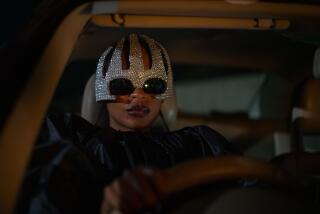Under a Southern Cross : FATHER MELANCHOLY’S DAUGHTER, <i> By Gail Godwin (William Morrow: $21.95; 512 pp.)</i>
- Share via
“Father Melancholy’s Daughter”--an elegant, intelligent and necessary novel--is the best book yet from Gail Godwin, who has published seven previous novels and two volumes of short stories. She began to attract a wide readership with “A Mother and Two Daughters” in 1982; then “A Southern Family” stayed on the New York Times best-seller list for 11 weeks, eliciting huzzahs from her faithful. Now it’s high time that Godwin attracts the readers--and the critical attention--which she richly merits.
Although Godwin was born in Alabama, grew up in Asheville, N.C., and went to school at Chapel Hill, her work is not really “Southern” at all. That is, she does not depend upon “storytelling,” nor upon eccentric characters and strong narrative voice. She does not write about the lower-middle class. There’s nary a moon pie, dead mule or Chevrolet to be found. Instead, her fiction is strongly thematic--ideas are as important as character and plot.
Godwin’s great topic is woman’s search for identity: A death in the family frequently precipitates this search. The tension between art and real life (many of her women are artists or would-be artists) is another thematic constant in her work. Her literate, smart women characters possess the free will to make choices, to take responsibility for their lives. She has said, “Since I began writing fiction I have been most interested in creating characters who operate at a high level of intelligence and feeling as they go about trying to make sense of the world in which they find themselves, and as they make decisions about how to live their lives.”
Margaret Gower, the narrator of “Father Melancholy’s Daughter,” is no exception, but her ability to make decisions is severely hampered by the care-taking role she must adopt as the child of a depressed--though beloved--clergyman father. Never has the trendy notion of co-dependence been given more real flesh than in the brilliant opening chapters of this novel.
Margaret’s burden is doubled when her mother Ruth leaves her and her father, going off on a sudden “vacation” with her theatrical friend Madelyn Farley, a vacation that stretches into “a week or ten days,” then evolves into a trip to England where Ruth is killed in a car accident. Margaret is only 6 when her mother leaves.
Years later, the older Margaret will wonder: “At what point did she know she was not coming back, or was there ever such a point? My father held fast to his belief that she would have returned to us had she lived.”
How much did Ruth’s leaving have to do with her desire to be a “real” artist like Madelyn, and how much did it have to do with Walter Gower’s frequent “depressions”? In one exchange, Walter wonders what would happen if he did not resort to medication, as he must:
“I mean, St. John-of-the-Cross didn’t gulp down a pill every time he felt another sleepless Dark Night coming on.”
“St. John-of-the-Cross didn’t have a wife and child, either,” my mother shot back.
After her mother leaves, Margaret deals with these bouts alone, wondering when Daddy will go back behind his “Black Curtain,” as he calls it.
“But why do you go there? You know you don’t enjoy it.”
“I certainly don’t,” he said, laughing. “Oh no, I do not enjoy it, my Margaret. Why do I go there? I’m not sure I know myself. It’s more as if I wander there, or get led there . . . and suddenly, before I know it, I’m behind the curtain again and everything is dark. I can remember what it was like, back in the world of light and meaning, but, you see, once I’m behind the curtain, I can’t find my way back. What’s worse, I sometimes don’t even want to. I don’t have the energy to want.”
Margaret’s response, of course, is to imagine that she can “fling open the Black Curtain and descend into the chambers of my father’s depression and walk alongside him naming each of its demons and confronting their dreadful visages until he would allow me to lead him back into the light . . . it would be all my responsibility.” In later years, Margaret will take her responsibility so seriously that she comes back home from her graduate studies in Charlottesville just to make sure her father’s favorite sweater is properly washed. She is too obsessed with care-taking to return the affections of Ben, her childhood friend and longtime lover.
Time passes and Father Walter gains a more literal cross to bear when local notions of progress demand that St. Cuthbert’s corner Calvary be torn down in order to widen a street servicing the new Sunset Villas. “CORNER CALVARY: LANDMARK OR BOTTLENECK?” demands a headline in the local paper. Tension grows, the cross is vandalized; in all the excitement, Father Gowan suffers a fatal heart attack, freeing Margaret at last to follow the dictates of her heart. But such freedom is terrifying, and she loved her father fiercely. (“Except when he was having his depressions, Daddy was the most congenial person I knew.”)
The ending of this novel feels rushed, and it is not altogether plausible (“A Mother and Two Daughters” was unrealistically tied up in a too-pretty bow, also). But at least the ending is surprising, though it is surprisingly hopeful; and at least it gives Margaret full credit for both intelligence and passion, qualities too often denied women characters.
More to Read
Sign up for our Book Club newsletter
Get the latest news, events and more from the Los Angeles Times Book Club, and help us get L.A. reading and talking.
You may occasionally receive promotional content from the Los Angeles Times.









